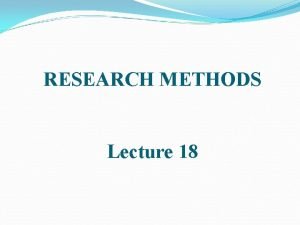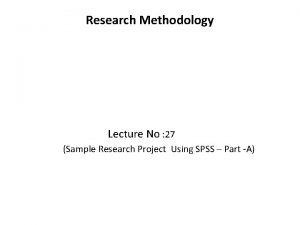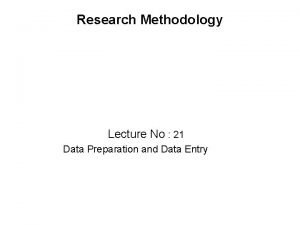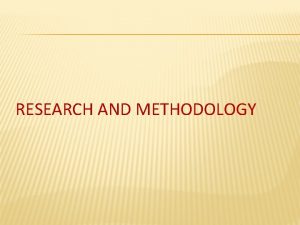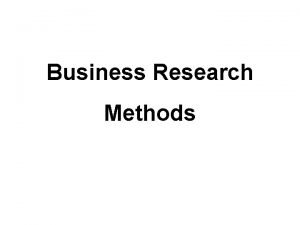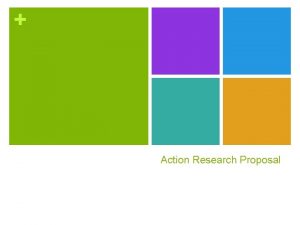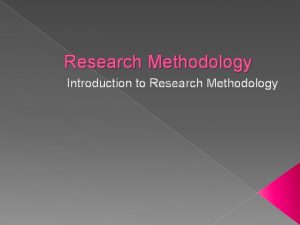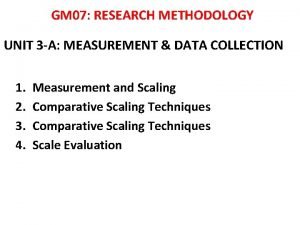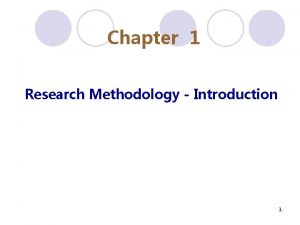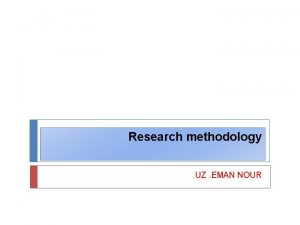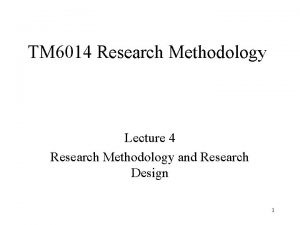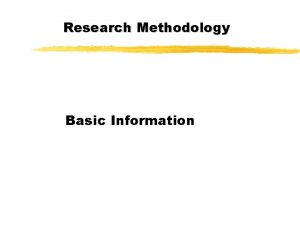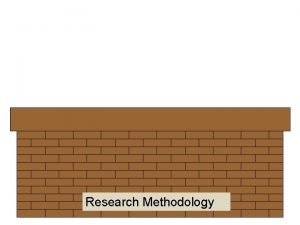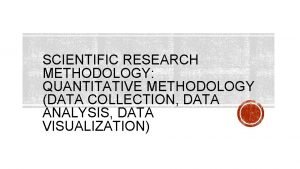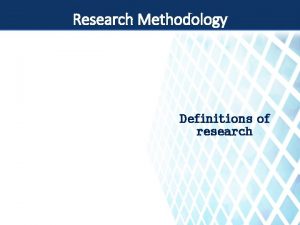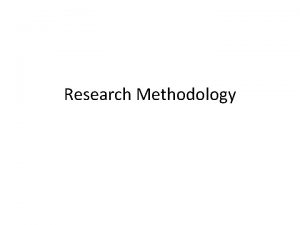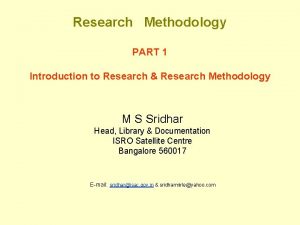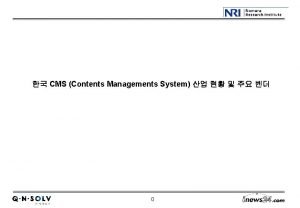Research Methodology 1 CONTENTS n n n n







































- Slides: 39

Research Methodology 1

CONTENTS n n n n n What is research methodology? What constitutes ﻳﺸﻝ a research topic? How to select a research topic? What are some of the limitations encountered when doing or thinking of doing a research project? What is a literature review? Where do I find sources of information for my literature review? How to select an appropriate methodology? What are some of the common types of qualitative methodology? What are some of the common types of quantitative methodology? What type of data to collect? How to collect data? How to analyze data? What are some of the tests used on categorical data? What are some of the tests used on continuous data? How to draw conclusions from data? How to present research findings? How to present your paper? 2

What is Research Methodology? n Is defined as a highly intellectual ﻓﻜﺮﻱ human activity used in the investigation of nature and matter and deals specifically with the manner in which data is collected, analyzed and interpreted 3

What Constitutes a Research Topic? n Unanswered question n n Unsolved question Concern Query Statement of inquiry 4

How or Why Select a Research Topic? n n n Personal interest Social problem Testing theory Prior research Program evaluation Minorities in research (Limited Studies) 5

What are some of the Limitations Encountered when Doing or Thinking of Doing a Research Project? n Time constraints ﺍﻟﻘﻴﻮﺩ n Financial consideration n Equipment limitations n Human resource limitations 6

What is a Literature review? n Systematic review of available resources q q q q Theoretical and conceptual ﺗﺼﻮﺭﻱ concepts Identification of independent and dependent variables Measurement and operational definitions Selection of appropriate research technique Sampling strategy Statistical technique Findings and conclusions of similar studies studied 7

independent and dependent nvariables For example, if a researcher wishes to see whethere is a relationship between numbers of hours studied and test scores on an exam, he must select a random sample of students, determine the hours each studied, and obtain their grades on the exam. A table can be made for the data, as shown: Student A B C D E F Hours Studied 6 2 1 5 2 3 Grade, (%) 82 63 57 88 68 75 8

The two variables for this study are called the independent variable and the dependent variable. n The independent variable is the variable that can be controlled or manipulated ﺍﻟﺘﻼﻋﺐ. In this case, “number of hours studied” is the independent variable and is designated as the x variable. n The dependent variable is the variable that cannot be controlled or manipulated. The grade the student received on the exam is the dependent variable, designated as the y variable. The reason for this distinction between the variables is that one assumes that the grade the student earns depends on the number of hours the student studied. 9

Also, one assumes that, to some extent, the student can regulate or control the number of hours he or she studies for the exam. Another example, if a researcher studies the effects of age on a person’s blood pressure, the researcher can generally assume that age affects blood pressure. Hence, the variable “age” can be called the independent variable and the variable “blood pressure” can be called the dependent variable. 10

Where do I find Sources of Information for my Literature Review? n n n n n Books Journals Internet Data bases Archives Interviews* Observations* Reports Records 11

How to Select an Appropriate Methodology? n What is the nature of the problem being investigated? n Is the problem being investigated subjective ﺷﺨﺼﻲ or objective? Four types of research methods: q Qualitative* q Quantitative* q Mixed (qualitative and quantitative) q Critical and action oriented ﻣﻮﺟﻪ 12

n Qualitative variables are variables that can be placed into distinct categories, according to some characteristic or attribute. For example, gender (male or female). n Quantitative variables are numerical in nature and can be ordered or ranked. Example: age is numerical and the values can be ranked. Examples of quantitative variables are heights, weights, and body temperatures 13

What are some of the Common Types of Quantitative Methodology? Quantitative methods can be used to seek empirical support for research hypotheses. n n n Surveys Longitudinal Cross-sectional, correlation Experimental Ex-post facto research 14

n A longitudinal study is a correlation research study that involves repeated observations of the same variables over long periods of time — often many decades. Longitudinal studies are often used in psychology to study developmental trends across the life span. n Cross-sectional studies (also known as crosssectional analyses, transversal ﻣﺴﺘﻌﺮﺽ studies, prevalence ﺍﻧﺘﺸﺎﺭ study) form a class of research methods that involve observation of all of a population, or a representative subset, at one specific point in time. 15

They differ from case-control studies in that they aim to provide data on the entire population under study, whereas case-control studies typically include only individuals with a specific characteristic, with a sample, often a tiny minority, of the rest of the population. Crosssectional studies are descriptive studies (neither longitudinal nor experimental). 16

n Ex post facto is a Latin expression that literally translates to mean something that occurs after the fact. Ex post facto study or after-the-fact research is a category of research design in which the investigation starts after the fact has occurred without interference from the researcher. 17

Qualitative Research Qualitative research is a method of inquiry employed in many different academic disciplines, traditionally in the social sciences, but also in market research and further contexts. Qualitative researchers aim to gather an indepth understanding of human behavior and the reasons that govern such behavior. In the conventional ﺗﻘﻠﻴﺪﻱ view, qualitative methods produce information only on the particular cases studied, and any more general conclusions are only propositions ﺍﻟﻤﻘﺘﺮﺣﺎﺕ. 18

What are some of the Common Types of Qualitative Methodology? n n Biographical Phenomenological Ethnographical Case study 19

Biographical n Biographical studies are undertaken for many reasons, depending not only on the people being studied, but also on those doing the studying. Each biographical study here consists of a brief summary of the person's life and work, including, as may be appropriate and available, a photographic or other image, list of publications, and links. 20

Phenomenological n Phenomenology begins with an experience or condition and, through the narration ﺍﻟﺮﻭﺍﻳﺔ of participants, of either a shared single incident or shared condition, investigates the effects and perceptions ﺍﻟﺘﺼﺭﺍﺕ of that experience. Phenomenological method interprets an experience or fact, by listening to the different stories of the participants. The method examines the phenomena through the subjective eyes of the participants. 21

Ethnographical n Ethnography ﻭﺻﻒ ﺍﻷﻌﺮﺍﻕ ﺍﻟﺒﺸﺮﻳﺔ is a research design aimed at exploring cultural phenomena. The resulting field study or a case report reflects the knowledge and the system of meanings in the lives of a cultural group. An ethnography is a means to represent graphically and in writing, the culture of a people. n (ethnographic study) In-depth study of a culture, which uses a combination of methods including participant observation 22

Case study n A case study is a research methodology common such as in social science. It is based on an in-depth investigation of a single individual, or a group. In the social sciences and life sciences, a case study (or case report) is a descriptive ﻭﺻﻔﻲ , exploratory ﺇﺳﺘﻄﻼﻋﻲ or explanatory ﺗﻮﺿﻴﺤﻲ analysis of a person, group or event. An explanatory case study is used to explore causation ﺍﻟﺴﺒﺐ in order to find underlying principles. 23

What Type of Data to Collect? n Categorical ﻣﻄﻠﻖ q q n n Nominal ﺇﺳﻤﻲ -observations that can be coded Ordinal ﺗﺮﺗﻴﺒﻲ -observations that can be ranked Continuous -Observations that can be counted or measured Mixed q matrix of categorical and continuous data Matrix: ﺟﺪﻭﻝ ﻣﻘﻡ ﺇﻟﻰ ﺧﻼﻳﺎ ﺃﻮ ﺧﺎﻧﺎﺕ : ﻣﺼﻔﻮﻓﺔ 24

Continuous variables n Continuous variables can assume all values between any two specific values. They are obtained by measuring. n Temperature, for example, is a continuous variable, since the variable can assume all values between any two given temperatures. 25

Nominal level of measurement n The nominal level of measurement classifies data into mutually exclusive (non overlapping) , exhausting categories in which no order or ranking can be imposed on the data. A sample of college instructors classified according to subject taught (e. g. , English, history, psychology, or mathematics) is an example of nominal-level measurement. Classifying survey subjects as male or female is another example of nominal-level measurement. 26

Ordinal level of measurement n The ordinal level of measurement classifies data into categories that can be ranked; precise differences between the ranks do not exist. Examples of ordinal-measured data are grades (A, B, C, D, F), rating scales, and rankings. 27

How to Collect Data? n n Observations Interviews Reports Records 28

What are some of the Tests Used on Categorical Data? n n n n Chi-squared test-to determine the relationship between variables Fisher’s test-to compare two unpaired groups Mc. Nemar’s test-to analyze a matched case-control study Kappa-to quantify interafter agreement Wilcoxon test- to compare one group to a hypothetical value Kruskal-Wallis test-to compare three or more groups Spearman test-to compare association between variables 29

What are some of the Tests Used on Continuous Data? n T test- to compare one or two groups n ANOVA-to compare three or more groups n Pearson test-to compare the association between variables 30

How to Draw Conclusions from Data? n Use of graphical presentations n Use of statistical analyses n Sharing data among colleagues and receiving constructive ﺑﺍﺀ feedback 31

How to Present Research Tables-matrix of rows and columns representing Findings? n n variables Figures-visual organization of data/observations -pictures -pie charts -line charts -bar charts -flow charts -organizational charts -cartogram charts -Gantt charts -scatter plot charts 32

How to Present your Paper n n n Provides useful guidelines on: q style q in text citations q references Writing should be clear, concise and plain General format should be: q q q paper size-8. 5 x 11 1” margins on all sides double spaced written in 12 point font using Times New Roman short title and page number on the upper right hand corner of every page 33

General Format n n n Title Abstract Main Body q q n methodology results discussion conclusions References 34

In-text Citation n Author’s last name and year of publication placed in parenthesis next to where the information is cited n Three or more authors, use the last name of the first author followed by et al. , year of publication 35

Referencing Style The most referencing style used is as follows: n n n Last name of author, followed by initials Last names of authors arranged alphabetically in the reference list* Capitalize the first letter of the first word in titles and subtitles Capitalize all major words in journal titles Italicize titles of books and journals 36

How to Collect Data? 37

How to Collect Data? n ++ 38

THANK YOU Dr. Ghani Albaali, Ph. D. THE END 39
 What is methodology
What is methodology Narrative report with contextual description
Narrative report with contextual description Objectives in research
Objectives in research Descriptive hypothesis
Descriptive hypothesis Objectives in research methodology
Objectives in research methodology Research methodology flow chart
Research methodology flow chart How to write methodology in research proposal
How to write methodology in research proposal Criteria of good measurement
Criteria of good measurement Dimensions of research methodology
Dimensions of research methodology Research methodology
Research methodology Example of theoretical framework in qualitative research
Example of theoretical framework in qualitative research Central editing in research methodology
Central editing in research methodology To gain familiarity with a phenomenon
To gain familiarity with a phenomenon Design methodology meaning
Design methodology meaning Ohio office of criminal justice services
Ohio office of criminal justice services Research methodology meaning
Research methodology meaning Type of research methodology
Type of research methodology Purpose of the study
Purpose of the study Procedures of data collection
Procedures of data collection Difference of research and design
Difference of research and design Chapter 3 components
Chapter 3 components Types of research methodology
Types of research methodology Method
Method Research proposal cover page apa
Research proposal cover page apa Ocar structure
Ocar structure Confounded relationship in research methodology
Confounded relationship in research methodology Research methods notes kenya
Research methods notes kenya Research methods midterm
Research methods midterm Methodology in research
Methodology in research Constant sum scale
Constant sum scale Methodology in research
Methodology in research Difference between conclusive and exploratory research
Difference between conclusive and exploratory research Formulating research methodology
Formulating research methodology Engineering research methodology
Engineering research methodology Research design
Research design True or false questions on research methodology
True or false questions on research methodology Research methodology in applied economics
Research methodology in applied economics The qualitative field research interview is typically
The qualitative field research interview is typically Pantry audits
Pantry audits Objectives of literature review
Objectives of literature review







